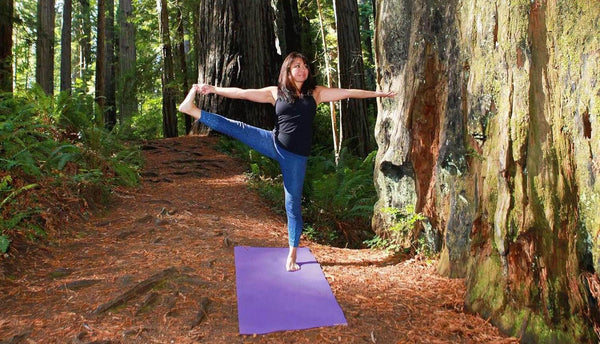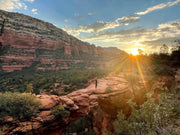It's hard to imagine a more grounding and restorative activity than spending time in nature, disconnecting from our daily routines.
Scientifically speaking, it's not just a feeling—it's a fact! Attention Restoration Theory (ART) has shown that immersing ourselves in the natural world can significantly improve our ability to concentrate, beat fatigue and relax.
Camping is an excellent opportunity to put this theory into practice.
As a mindfulness meditation teacher, I wanted to share some of my favorite practices to elevate your camping experience through tuning in to your senses and opening up to the present moment.

Photo: Camping trip at Paso Picacho, Southern California.
8 Mindful and Fun Camping Activities to Awaken Your Senses (+3 New Activities!)
- Mindful Journaling – Connect with Inner Voice
- Mindful Eating – Connect with Simple Nourishment
- Sunset Gratitude Ritual – Connect with Daily Blessings
- Digital Detox – Connect with the Present Moment
- Mindful Stargazing – Connect with the Cosmos
- Reading in a Hammock – Connect with Quiet Joy
- Mindful Walking – Connect with Each Step
- Forest Bathing – Connect with Living Nature
- Mindful Bench Tour – Connect with Shared Humanity
- Yoga Outdoors – Connect Body and Mind
- Sense Foraging – Connect with Wild Senses
- Mindful Listening – Connect with Each Other
Tip: Slow down once you've arrived and set up camp. Shift gears into a more relaxed mindset by consciously slowing your breath and movements. Walk slower, talk softer, savor every sip of your favorite drink. When we calm the body, the mind naturally follows.
-
Mindful Journaling - Connect with Your Inner Voice
Bring a journal and a pen, and take time each day to write about your experiences, thoughts, and feelings. If nothing comes to mind, start with simple observations ("I see a bird," "The sun feels warm"). Journaling is a powerful tool for processing experiences and emotions.
One of my favorite techniques is "morning pages," a free-writing method from Julia Cameron's The Artist's Way. It's simple and only takes 15-20 minutes: first thing in the morning, write three pages of longhand, stream-of-consciousness writing. Don't edit, just let your thoughts flow onto the page. It can unlock creativity, reduce stress, and deepen understanding of oneself. "Just keep the hand moving," a tip from my writing coach.
-
Mindful Eating – Connect with Simple Nourishment
How about starting the day with a mindful breakfast? Whip up some campsite pancakes with a just-add-water mix (we like the wholegrain, protein-rich Kodiak Cakes). Just shake it in an empty water bottle, pour into a pan, and voilà—the ultimate comfort breakfast is served!

Now, as you savor each bite, experiment with mindful eating, a practice taught in Jon Kabat-Zinn's Mindfulness-Based Stress Reduction (MBSR) program: the art of being present with your food.
It's not about counting calories or judging your food choices. Instead, it's about being fully attentive to your food, flavors and textures, sensations in the body and appreciation of the nourishment it receives.
Tip: to make mindful eating experience even more special, find a place with a beautiful view to enjoy a snack or desert: the summit of a mountain, a quiet spot by the river, or a welcoming shade under a tree. Any place that feels peaceful is a good choice.
-
Sunset Gratitude Ritual – Connect with Daily Blessings
Find a cozy spot where you can have a nice view of the setting sun – sunsets in the wilderness are magical! Observe how the colors shift and fade. Then, bring to mind one thing you're grateful for today. It could be a simple pleasure, a kind gesture, personal accomplishment, or simply the feeling of sunshine on your skin. Let that feeling of gratitude wash over you as you bask in the warmth of the fading light.

-
Digital Detox: disconnect to reconnect
As challenging as it may seem, unplugging from the digital world can be the most refreshing part of your camping trip. Imagine: no emails, no notifications, just the sounds of nature and the warmth of good company. We like to settle around the campfire or beach bonfire and share stories.
If a full-on digital detox feels unrealistic, start small. Commit to a specific time each day when everyone in your group powers down their devices. "Sun down, phone down" is a fun and easy rule to remember. You'll be surprised how quickly your mind and body adjust to the peace and quiet.

-
Mindful Stargazing – Connect with the Cosmos
Far from city's light pollution, the ancient light from the distant stars and galaxies looks brighter and closer with many more constellations than we can normally see back home.
You can use apps like SkyView for iPhone or Star Tracker for Android to easily identify constellations. Simply point your phone to the sky to discover stars, planets and even galaxies far away!
Want to add some friendly competition? Challenge your fellow campers to a constellation-spotting contest. Who knows, you might even discover a new favorite star cluster!
-
Relax with a book in a camping hammock
Escape into the pages of a good book while swaying gently in a camping hammock. It's a simple pleasure, yet incredibly restorative. Camping hammocks are lightweight, inexpensive, and easy to pack—a worthy addition to your gear. We like this $10 budget-friendly option, the WiseOwl hammock with straps, or this spacious two-person stand-alone hammock for treeless spots. Don't be surprised if you drift off for a nap mid-chapter—it's all part of the hammock mindfulness.
-
Guided Walking Meditation – Connect with Each Step
This is a great moving meditation to help get out of your head and into your body. It's especially helpful when your mind is racing and seated silent meditation isn't appealing. Simply pop in some earphones and enjoy your walk with a guided meditation. We like this 30-minute guided walking meditation on Spotify, but there are many free options on YouTube or the Insight Timer. Bonus: you'll get your steps in and plenty of fresh air!

-
Sense Foraging – Connect with Wild Senses
Camping naturally immerses us in a sensory-rich environment, yet our minds often remain busy. "Sense foraging" is a simple mindfulness technique to awaken your senses, allowing the living world of nature to fill your awareness.
Why It Works:
Stress and the daily grind can dull our senses, leading to a feeling of being disconnected from our bodies and the world around us. Ever felt like you're just going through the motions?
Sense foraging acts as a reset button, tuning in to our senses and allowing us to fully experience the richness of the world around.
How to Practice Sense Foraging at Camping
- Set an Intention: Begin your camping trip with the intention to engage fully with your senses. Simply setting this intention can open you up to more vivid and meaningful sensory experiences.
- Engage each sense:
Touch: Feel the warmth of the sun on your skin, the cool morning dew on your feet or the cozy cocoon of your sleeping bag in a tent on a crisp morning.
Sight: Notice the sunlight filtering through leaves or the vibrant colors of wildflowers.
Smell: Inhale the scent of pine needles or the campfire smoke.
Sound: Listen to the crackling fire, the wind rustling through trees.
Taste: Savor the smoky sweetness of s'mores or the first sip of morning coffee.

Sense Foraging Meditation
A fun way to practice sense foraging is the "5-4-3-2-1" meditation. This practice guides you to activate each of the senses and can reveal a surprising richness in your sensory experience:
- See: Name five things you can see around you.
- Touch: Feel four sensations in the body or on the skin.
- Hear: Name three sounds you can hear, near or far.
- Smell: Sense two distinct smells.
- Taste: Name one thing you can taste.

Looking for more guidance? Check out the book "Better in Every Sense: How the New Science of Sensation Can Help You Reclaim Your Life" for deeper insights into the power of your senses. Plus, it's great for reading in that hammock!
-
Forest Bathing – Connect with Living Nature
Retreat to the woods and experience shinrin-yoku, the Japanese art of natural wellness. Born in Japan in the 1980s, shinrin-yoku was developed as a response to the increasing stress arising from urban living.
Why Forest Baths Work:
Studies have shown that this practice reduces stress, lowers blood pressure, and boosts mood and immune function. By slowing down and tuning into the sensory details of the forest, you create a space for relaxation and healing, allowing the natural world to restore and rejuvenate your mind and body.
In addition, the natural aromatherapy of the forest, thanks to the release of phytoncides (essential oils) from trees, has been linked to lifting depression and reducing anxiety.
How to Practice Shinrin-Yoku:
Even a short forest bath can work wonders. Find a nearby trail in a wooded area, leave your phone behind, and simply wander. Remember it’s not a hike, it's a slow-paced saunter through the green world.

If that feels comfortable, consider taking your shoes off and walking barefoot. This science-backed technique, also known as earthing or grounding, has shown that connecting to the Earth's natural energy - by walking barefoot on grass, sand, dirt or rock - can reduce inflammation, improve sleep and even diminish chronic pain.
To deepen your experience, consider seeking out a Certified Shinrin-Yoku Instructor or Forest Therapy Guide. These trained experts can offer "invitations" and grounding exercises, like barefooting and earthing, that encourage participants to experience the natural environment in a whole new multi-sensory way.
Along the way, you'll also learn more about the local ecosystem, perhaps even finishing the day with a tea ceremony—and go home with a new sense of peace. You can find a guide in your area at Forest Bathing Finder. If a certified guide is unavailable, simply let nature be your guide.
Watch this beautiful trailer to get a taste of shinrin-yoku:
-
Go on a Bench Tour - Connect with Shared Humanity
There's more to a park bench than meets the eye. Try a “bench tour” during your camping trip to discover unique benches and the stories they hold. Take a leisurely stroll through time and stories—see what you discover.
Enjoy a moment to sit on each bench, and you’ll often find plaques commemorating individuals, sharing whose memory the bench is dedicated to, and sometimes even their favorite sayings. Each one holding a little piece of history, an echo of someone's life.
These small tributes evoke a sense of timelessness and interconnectedness, reminding us of the shared human experience. It's a surprisingly peaceful way to connect with something larger than yourself.
I've begun collecting photos of unique benches from around the world, and here are a few favorites. What hidden treasures will you discover on your bench tour? I invite you to send us your photo to contribute to our growing collection of special benches from every corner of the globe!

-
Outdoor Yoga – Connect Body and Mind
Check out these eco-friendly yoga mats for your trip
Unroll your yoga mat or blanket under the open sky and let the natural world enhance your practice. Outdoor yoga deepens your mind-body connection as you feel the earth beneath you and the elements around you. Let the sounds of nature be your soundtrack as you move through your favorite poses.
Don't worry if you're unsure of a sequence. A deck of yoga pose cards, like the Asana Moon Yoga Cards, can guide your practice. Their clear instructions and beautiful illustrations make them perfect for all levels. Just remember to choose a safe, comfortable spot, wear sunscreen, and stay hydrated!

Tip: give yourself plenty of Savasana time at the end of your yoga session, we recommend a minimum of 10 minutes.
Mindful Listening – Connect with Each Other
Nature has a way of opening us up, and camping creates the perfect backdrop for conversations and storytelling. Many of the activities you’ve already explored can lead to some great discussions! Once the tents are up and the kettle’s on, try one of these:
-
Journaled today? Share something surprising or honest that came up in your writing.
-
Tried forest bathing or yoga on a rough forest floor? Describe what it felt like to immerse yourself in the sounds, scents, and stillness of the woods. What shifted in your body or mood?
-
Did the sunset gratitude? Share one thing that made you feel good today — no matter how small.
-
Made campsite pancakes? Reflect on how food tastes different when prepared over a real fire.
More prompts to explore:
-
What’s one moment from today you’ll remember?
-
When do you feel most peaceful?
-
Is there something you’re ready to let go of?
If literally nothing comes to mind, being comfortably quiet together can be one of the nicest bonding experiences. Otherwise, there's an app for that! I like the PartyQs app for mindful and fun questions for friends, couples, and families.

Final thoughts on mindful outdoors time
Recently, a dear friend, a successful career woman and avid traveler, shared how our mindful approach to our Portugal trip transformed her experience. By intentionally slowing down and incorporating mindfulness practices into our travels, we savored each moment, prioritizing quality over quantity. She vividly recalls the intricate patterns of Portuguese ceramic tiles in a small Nazare church and the delicate sweetness of freshly baked "Pastéis de Nata" in Porto. This newfound appreciation for the present moment, she believes, stems from being more attuned to herself and the world around her.
I hope this inspires you to venture outside and explore the outdoors this season, senses wide open. ☘️
Ready to elevate your next camping trip? Save this quick guide to Camping Wellness on your phone for 8 easy ways to transform your outdoor adventure into your own wellness retreat.









Leave a comment